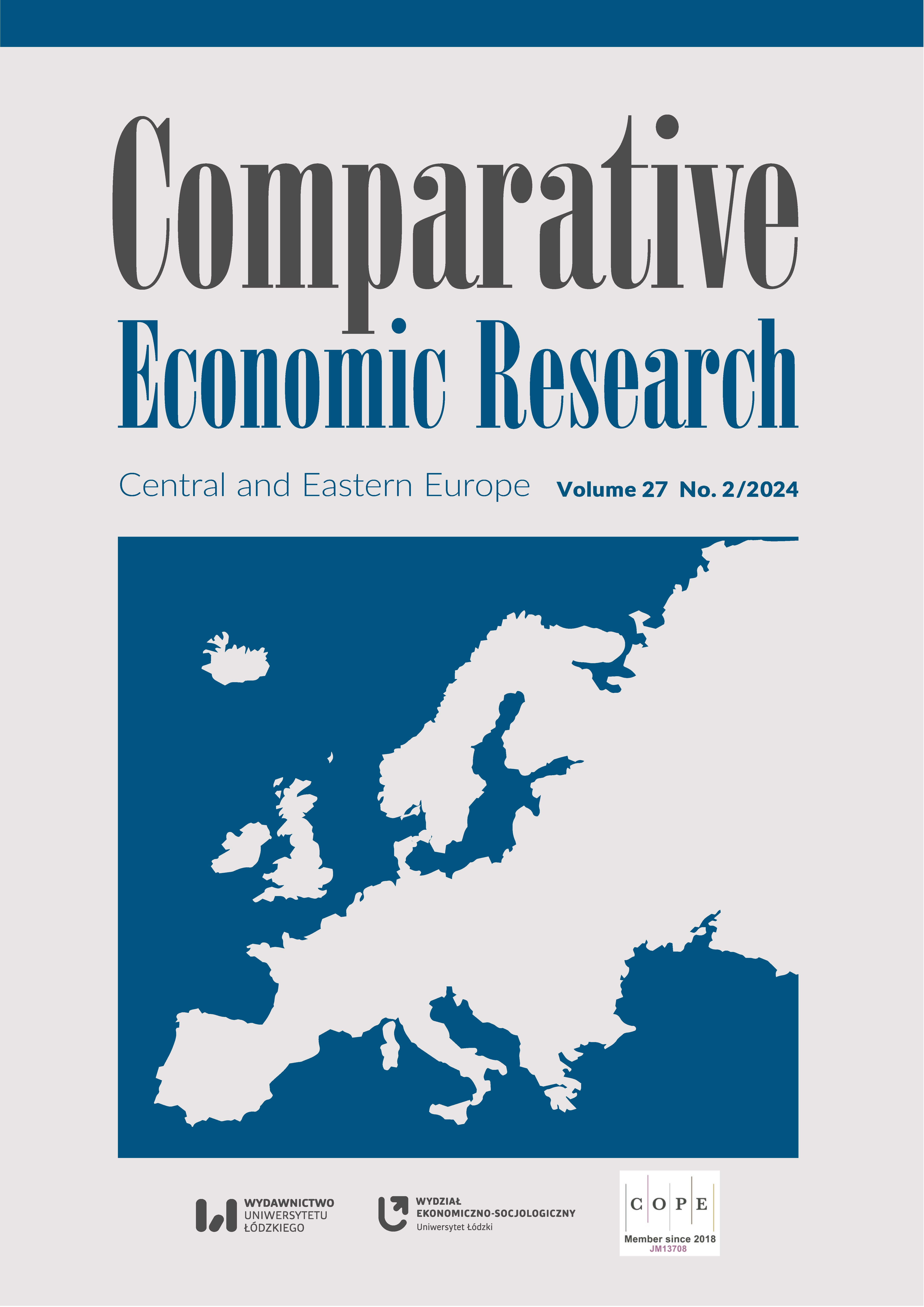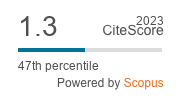The Concept of Structural Equation Modelling for Measuring the Shadow Economy – International and Polish Perspectives
DOI:
https://doi.org/10.18778/1508-2008.27.14Keywords:
shadow economy, national statistical offices, structural equation models, unobserved variables, international economyAbstract
The goal of the article is to explore the potential of explicatory Structural Equation Modelling (SEM) and its specifications for measuring the shadow economy (SE). This is done from the perspective of various approaches in selected countries. The article is a review and conceptual paper. The study is divided into three stages: a comprehensive description of the nature of the SE and the difficulties associated with measuring it; a comparative analysis of the approaches applied in selected EU countries (with particular emphasis on Italy and Poland), and finally, the concept of SE estimation based on SEM model is proposed.
One of the most important limitations regarding the SE is that it is not possible to measure the extent of this phenomenon directly. This leads to the use of non‑standard estimation techniques based on latent variable models. The innovation of this approach is that it considers three factors that are not directly observable, i.e., tax morality, concealing salaries, and regulation of the economy.
The proposed model allows us to capture and explain empirical SE phenomena more precisely and effectively than with classical statistical and econometric methods. However, we are aware that it is highly probable that many SEMs will need to be tested and modified to achieve the final result.
Downloads
References
Aigner, D.J., Schneider, F., Ghosh, D. (1988), Me and my shadow: estimating the size of the U.S. hidden economy from time series data, [in:] W.A. Barnett, E.R. Berndt, H. White (eds.), Dynamic Econometric Modelling. Proceedings of the Third International Symposium in Economic Theory and Econometric, Cambridge University Press, Cambridge, pp. 297–334, https://doi.org/10.1017/CBO9780511664342.015
Google Scholar
DOI: https://doi.org/10.1017/CBO9780511664342.015
Błasiak, Z.A. (2018), Przydatność metod ekonometrycznych w badaniach nad szarą strefą, “Roczniki Ekonomii i Zarządzania”, 10 (2), pp. 134–175, https://doi.org/10.18290/reiz.2018.10.2-10
Google Scholar
DOI: https://doi.org/10.18290/reiz.2018.10.2-10
Bollen, K.A. (1989), Structural Equations with Latent Variables, John Wiley & Sons, New York–Chichester–Brisbane–Toronto–Singapore, https://doi.org/10.1002/9781118619179
Google Scholar
DOI: https://doi.org/10.1002/9781118619179
Breusch, T. (2005), Estimating the Underground Economy using MIMIC Models, “Working Paper”, Canberra, https://econwpa.ub.uni-muenchen.de/econ-wp/em/papers/0507/0507003.pdf (accessed: 30.08.2019).
Google Scholar
Buehn, A., Schneider, F. (2008), MIMIC Models, Cointegration and Error Correction: An Application to the French Shadow Economy, “IZA Discussion Paper”, 3306, https://doi.org/10.2139/ssrn.1135882
Google Scholar
DOI: https://doi.org/10.2139/ssrn.1135882
Buehn, A., Schneider, F. (2016), Estimating the Size of the Shadow Economy: Methods, Problems and Open Questions, “IZA Discussion Paper”, 9820, http://ftp.iza.org/dp9820.pdf (accessed: 30.09.2018).
Google Scholar
DOI: https://doi.org/10.2139/ssrn.2750303
Cichocki, S. (2006), Przegląd metod pomiaru szarej strefy, “Gospodarka Narodowa”, 205 (1–2), pp. 37–61, https://doi.org/10.33119/GN/101449
Google Scholar
DOI: https://doi.org/10.33119/GN/101449
Cliff, N. (1983), Some Cautions Concerning the Application of Causal Modelling Methods, “Multivariate Behavioral Research”, 18 (1), pp. 115–136, https://doi.org/10.1207/s15327906mbr1801_7
Google Scholar
DOI: https://doi.org/10.1207/s15327906mbr1801_7
Dell’Anno, R., Schneider, F. (2003), The Shadow Economy of Italy and other OECD Countries: What do we know?, “Journal of Public Finance and Public Choice”, 21 (2–3), pp. 97–120, https://doi.org/10.1332/251569203X15668905422009
Google Scholar
DOI: https://doi.org/10.1332/251569203X15668905422009
Dell’Anno, R., Schneider, F. (2006), Estimating the underground economy by using MIMIC models: A response to T. Breusch’s critique, “Economics Working Papers”, 2006–2007, Department of Economics, Johannes Kepler University Linz.
Google Scholar
Dell’Anno, R., Gomez-Antonio, M., Pardo, A. (2007), The shadow economy in three Mediterranean countries: France, Spain and Greece. A MIMIC approach, “Empirical Economics”, 33, p. 197, https://doi.org/10.1007/s00181-007-0138-1
Google Scholar
DOI: https://doi.org/10.1007/s00181-007-0138-1
Dybka, P., Kowalczuk, M., Olesiński, B., Rozkrut, M., Torój, A. (2017), Currency demand and MIMIC models: towards a structured hybrid model-based estimation of the shadow economy size, “SGH KAE – Working Papers”, 30, https://cor.sgh.waw.pl/handle/20.500.12182/1168
Google Scholar
Dymarski, D. (2016), Estymacja rozmiaru szarej strefy w oparciu o dane ankietowe gospodarstw domowych, Doctoral dissertation, https://depotuw.ceon.pl/bitstream/handle/item/1404/Konrad_Dymarski_rozprawa_doktorska.pdf?sequence=1 (accessed: 20.09.2019).
Google Scholar
Efendic, N., Pasovic, E., Efendic, A.S. (2018), Understanding the Informal Economy in Practice: Evidence from Bosnia and Herzegovina, “e-Finanse”, 14 (4), pp. 77–89, https://doi.org/10.2478/fiqf-2018-0029
Google Scholar
DOI: https://doi.org/10.2478/fiqf-2018-0029
Frey, B.S., Weck-Hanneman, H. (1984), The hidden economy as an ‘unobserved variable’, “European Economic Review”, 26 (1–2), pp. 33–53, https://doi.org/10.1016/0014-2921(84)90020-5
Google Scholar
DOI: https://doi.org/10.1016/0014-2921(84)90020-5
Fundowicz, J., Łapiński, K., Wyżnikiewicz, B., Wyżnikiewicz, D. (2019), Szara strefa 2019, Instytut Prognoz i Analiz Gospodarczych, Warszawa.
Google Scholar
Gatnar, E. (2003), Statystyczne modele struktury przyczynowej zjawisk ekonomicznych, Wydawnictwo Akademii Ekonomicznej w Katowicach, Katowice.
Google Scholar
Giles, D.E.A. (1995), Measuring the size of the hidden economy and the tax gap in New Zealand: an econometric analysis, “Working Paper No. 5a, Working Paper on Monitoring the Health of the Tax System”, Inland Revenue Department, Wellington.
Google Scholar
Giles, D.E.A. (1999), Modeling the hidden economy in the tax-gap in New Zealand, “Empirical Economics”, 24, pp. 621–640, https://doi.org/10.1007/s001810050076
Google Scholar
DOI: https://doi.org/10.1007/s001810050076
Giles, D.E.A., Tedds, L.M. (2002), Taxes and the Canadian Underground Economy, “Canadian Tax Paper”, 106, Canadian Tax Foundation, Toronto.
Google Scholar
Grzegorzewska-Mischka, E., Wyrzykowski, W. (2015), Szara strefa jako skutek polityki podatkowej państwa, “Zarządzanie i Finanse”, 3, pp. 149–164.
Google Scholar
GUS (2022), Rachunki narodowe według sektorów i podsektorów instytucjonalnych w latach 2017–2020, Zakład Wydawnictw Statystycznych, Warszawa.
Google Scholar
Jöreskog, K.G. (1973), A General Method for Estimating a Linear Structural Equation System, [in:] A.S. Goldberger, O.D. Duncan (eds.), Structural Equation Models in the Social Sciences, Academic Press, New York, pp. 85–112.
Google Scholar
Jöreskog, K.G., Sörbom, D. (1993), LISREL 8: Structural Equation Modeling with the SIMPLIS Command Language, Scientific Software International, Chicago.
Google Scholar
Kaplan, D. (2000), Structural equation modeling: foundations and extensions, Sage Publications, Thousand Oaks.
Google Scholar
Kline, R.B. (2011), Principles and Practice of Structural Equation Modeling, Guilford Press, New York.
Google Scholar
Konarski, R. (2014), Modele równań strukturalnych. Teoria i praktyka, Wydawnictwo Naukowe PWN, Warszawa.
Google Scholar
Lackó, M. (2000), Hidden Economy – an Unknown Quantity? Comparative Analysis of Hidden Economies in Transition Countries, 1989–95, “The Economics of Transition”, 8 (1), pp. 117–149, https://doi.org/10.1111/1468-0351.00038
Google Scholar
DOI: https://doi.org/10.1111/1468-0351.00038
Malczewska, P. (2019), Szara strefa gospodarki. Determinanty i mechanizmy kształtowania, Wydawnictwo Uniwersytetu Łódzkiego, Łódź, https://doi.org/10.18778/8142-229-1
Google Scholar
DOI: https://doi.org/10.18778/8142-229-1
Medina, L., Schneider, F. (2018), Shadow Economies around the World: What Did We LEARN Over the Last 20 Years?, “International Monetary Fund Working Paper”, WP/18/17, https://doi.org/10.5089/9781484338636.001
Google Scholar
DOI: https://doi.org/10.5089/9781484338636.001
Misztal, P. (2018), Istota i znaczenie szarej strefy w krajach członkowskich Unii Europejskiej, “Roczniki Ekonomii i Zarządzania”, 10 (46), p. 2, https://doi.org/10.18290/reiz.2018.10.2-2
Google Scholar
DOI: https://doi.org/10.18290/reiz.2018.10.2-2
Mróz, B. (2002), Gospodarka nieoficjalna w systemie ekonomicznym, Wydawnictwo Szkoły Głównej Handlowej, Warszawa.
Google Scholar
OECD (2002), Measuring the Non-Observed Economy: A Handbook, OECD, Paris.
Google Scholar
Orsi, R., Davide, D., Turino, T. (2014), Size, Trend, and Policy Implications of the Underground Economy, “Review of Economic Dynamics”, 17 (3), pp. 417–436, https://doi.org/10.1016/j.red.2013.11.001
Google Scholar
DOI: https://doi.org/10.1016/j.red.2013.11.001
Piecuch, T., Szczygieł, E. (2018), Przedsiębiorczość szarej strefy, “Roczniki Ekonomii i Zarządzania”, 10 (46), p. 2, https://doi.org/10.18290/reiz.2018.10.2-6
Google Scholar
DOI: https://doi.org/10.18290/reiz.2018.10.2-6
Regulation (EU) No. 549/2013 of the European Parliament and of the Council of May 21, 2013.
Google Scholar
Schneider, F. (2005), Shadow Economies around the World: What Do We Really Know?, “European Journal of Political Economy”, 21 (3), pp. 598–642, https://doi.org/10.1016/j.ejpoleco.2004.10.002
Google Scholar
DOI: https://doi.org/10.1016/j.ejpoleco.2004.10.002
Staniec, I. (2018), Modelowanie równań strukturalnych w naukach o zarządzaniu, “Organizacja i Kierowanie”, 2, pp. 65–77.
Google Scholar
Szewczyk-Jarocka, M. (2011), Analiza wybranych metod bezpośrednich i pośrednich służących do badania szarej strefy, “Zeszyty Naukowe PWSZ w Płocku. Nauki Ekonomiczne”, XIV, pp. 31–44.
Google Scholar
Urząd Statystyczny w Kielcach (2011), Gospodarka nieobserwowana w rachunkach narodowych, non-published materials, Kielce.
Google Scholar
Zagoršek, H., Jaklič, M., Hribernik, A. (2009), The Shadow Economy and Its Impact on National Competitiveness: The Case of Slovenia, “South East European Journal of Economics and Business”, 4 (1), pp. 37–50, https://doi.org/10.2478/v10033-009-0003-6
Google Scholar
DOI: https://doi.org/10.2478/v10033-009-0003-6
Downloads
Published
How to Cite
Issue
Section
License

This work is licensed under a Creative Commons Attribution-NonCommercial-NoDerivatives 4.0 International License.











